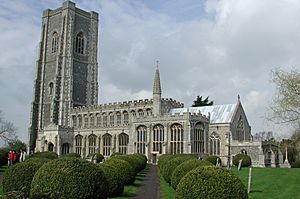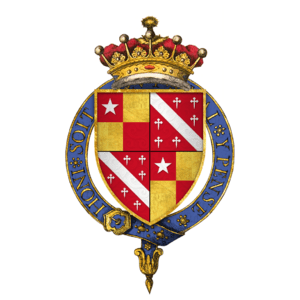John de Vere, 13th Earl of Oxford facts for kids
Quick facts for kids
John de Vere
|
|
|---|---|
| Born | 8 September 1442 |
| Died | 10 March 1513 (aged 70) Castle Hedingham, Essex |
| Title | 13th Earl of Oxford |
| Tenure | 26 February 1462 – 1475 1485 – 10 March 1513 |
| Spouse(s) | Margaret Neville Elizabeth Scrope |
| Issue | Katherine de Vere (illegitimate) |
| House | De Vere |
| Father | John de Vere, 12th Earl of Oxford |
| Mother | Elizabeth Howard |
|
|
|
John de Vere, 13th Earl of Oxford KG KB (born 8 September 1442 – died 10 March 1513) was a very important English nobleman. He lived during a time called the Wars of the Roses, which was a big fight between two powerful families, the Lancastrians and the Yorkists, for control of England's throne. John de Vere was a strong supporter and leader for the Lancastrian side.
He was the main commander of King Henry VII's army at the famous Battle of Bosworth Field. He also led Henry's troops to victory again at the Battle of Stoke Field a few years later. Because of his loyalty and skill, he became one of the most important people in King Henry VII's government.
Contents
Early Life and Challenges
John de Vere, the 13th Earl of Oxford, was born on 8 September 1442. He was the second son of John de Vere, 12th Earl of Oxford, and Elizabeth Howard.
Family Troubles and Royal Favor
In February 1462, John's father, the 12th Earl, and his older brother, Aubrey de Vere, faced serious charges. They were accused of plotting against King Edward IV and were sadly executed.
King Edward IV, however, wanted to make peace with some Lancastrian families. So, he allowed John de Vere to become the new Earl of Oxford. On 18 January 1464, John was given permission to take control of his family's lands.
Early Roles and Imprisonment
On 26 May 1465, John de Vere was made a Knight of the Bath. This happened during the coronation of King Edward IV's wife, Elizabeth Woodville. John had important roles at the ceremony, acting as the Lord Great Chamberlain and the Queen's Chamberlain.
However, in November 1468, he was sent to the Tower of London. He admitted to planning with the Lancastrians against the King. He was probably released by early 1469 and received a royal pardon.
Changing Sides and Escapes
By July 1469, Oxford joined some unhappy Yorkists, including his brother-in-law, the Earl of Warwick. After a defeat at Losecoat Field in March 1470, he had to flee to France. There, he joined Margaret of Anjou, King Henry VI's wife.
In September 1470, Oxford helped Warwick invade England, which put King Henry VI back on the throne. Oxford was made the Lord High Constable of England. In March 1471, he stopped King Edward IV's army from landing in Norfolk.
He commanded the right side of the army at the Battle of Barnet on 14 April 1471. His early success turned into a disaster when his soldiers started taking things from the battlefield.
After this defeat, Oxford escaped to Scotland with 40 men, including his two brothers. From Scotland, he went to France. There, he gathered ships and became a privateer, which meant he used his ships to attack enemy vessels.
Capture and Escape from Hammes Castle
Even though his lands were taken, Oxford was not officially declared a traitor after leaving England in 1471. His wife, Margaret, faced many financial difficulties. On 30 September 1473, he took control of St Michael's Mount in Cornwall. He was surrounded there for several months.
After most of his men left and he was wounded, Oxford had to surrender on 15 February 1474. He was then imprisoned at Hammes Castle near Calais. In 1475, he officially lost his titles and lands.
In 1484, the new king, Richard III, ordered Oxford to be moved to England. But before this happened, Oxford managed to escape! He even convinced the castle captain, Sir James Blount, to join him. They went to join the Earl of Richmond, who would later become King Henry VII. It is said that Richmond was incredibly happy when Oxford joined him.
Victory at Bosworth Field
Oxford returned to Hammes to bring the soldiers there to join Richmond. At the Battle of Bosworth Field, Oxford led the archers and Henry's main attack. His special formation, called the Oxford Wedge, broke through King Richard's army. In this fierce battle, John Howard, the Duke of Norfolk, who was leading Richard III's attack, was killed.
To celebrate the victory at Bosworth, Oxford ordered the building of the church of St. Peter and St. Paul in Lavenham.
Serving King Henry VII
After King Henry VII won the throne, Oxford was immediately seen as one of the most important people in the new government. He got his titles and lands back and received many important jobs.
Important Roles and Honors
On 21 September 1485, he was made the Lord Admiral. The next day, he became the chief steward of the Duchy of Lancaster and the Constable of the Tower of London. He was also the first Captain of the Yeomen of the Guard, who were the King's personal bodyguards.
Oxford joined the King's Privy Council, a group of important advisors. He was also recognized as the Hereditary Lord Great Chamberlain of England. This meant he had a special role at royal events. He helped at the coronations of King Henry VII and Elizabeth of York, carrying the King's train and even placing the crown on the King's head at the coronation dinner.
By 1486, he had been given the Order of the Garter, one of England's highest honors. He was present at most major court events. In 1486, he was even godfather to the King's oldest son, Arthur, Prince of Wales.
Continued Military Service
Oxford's fighting days were not over. In 1487, he led the main attack at the Battle of Stoke Field, which was the last major battle of the Wars of the Roses. In 1492, he was in Picardy, France. In 1497, he was one of the commanders against the Cornish rebels at Blackheath.
He also oversaw the trial of the Earl of Warwick in 1499. By 1499, Oxford's yearly income from his lands had grown quite a lot. He often hosted the King at his homes.
Later Life and Legacy
When King Henry VIII became king, Oxford continued to be highly respected. He again served as Lord Great Chamberlain at the new King's coronation.
Homes and Interests
Oxford lived at Wivenhoe and Castle Hedingham in Essex. He added to the old castle keep at Hedingham and built a new great hall and several towers. His special helmet for jousting (a knight's sport) is now in a museum in Florence, Italy.
Oxford was also interested in music and books. He had an excellent chapel choir. He also asked William Caxton, a famous printer, to print a book called The Four Sons of Aymon in 1489. Oxford also had a group of actors who performed plays between 1492 and 1499.
Death and Successor
Oxford passed away on 10 March 1513 at Castle Hedingham. He was buried on 24 April at Colne Priory. He did not have any children from his two marriages. His nephew, John de Vere, 14th Earl of Oxford, became the next Earl.
Marriages and Family
John de Vere married twice.
First Marriage
His first wife was Margaret Neville. She was the daughter of Richard Neville, 5th Earl of Salisbury. Margaret was also the sister of Richard Neville, 16th Earl of Warwick, who was known as "the Kingmaker." This made Oxford the uncle of Anne Neville, who later became Queen of England when she married King Richard III. Margaret Neville died between late 1506 and early 1507.
Second Marriage
Oxford's second wife was Elizabeth Scrope. She was the widow of his friend William Beaumont, 2nd Viscount Beaumont. Elizabeth was the daughter of Sir Richard Scrope.
John and Elizabeth did not have any children together. Elizabeth, the Countess of Oxford, died in 1537. She mostly lived at Wivenhoe in Essex when she was not at court. She and her sister were part of Catherine of Aragon's household and attended important royal events.
Illegitimate Daughter
It is believed that the Earl of Oxford had an illegitimate daughter named Katherine de Vere. She married Sir Robert Broughton, who was a very wealthy landowner in England.
Sir Robert Broughton and Katherine de Vere had two sons and one daughter:
- John Broughton (died 1518), who had a son and two daughters.
- Robert Broughton.
- Margaret Broughton, who married Henry Everard and had several children.



